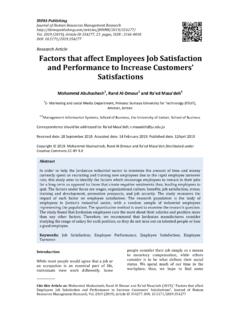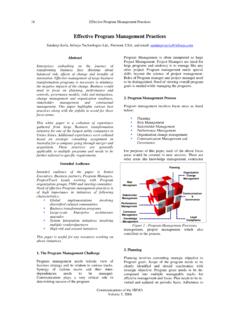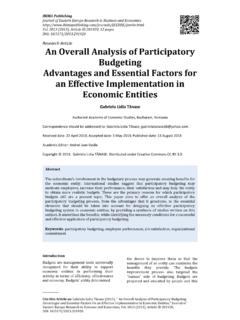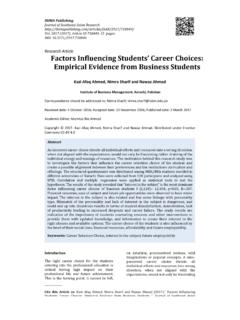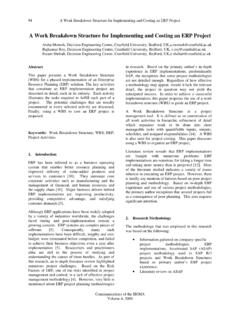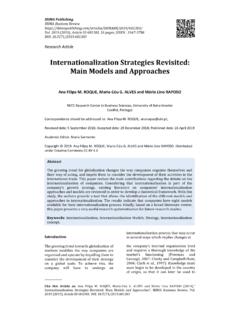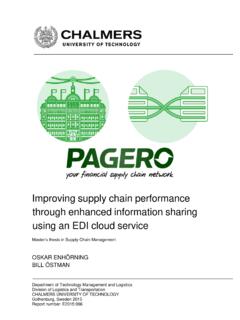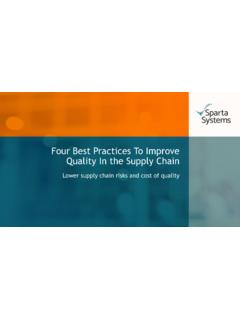Transcription of Supply Chain Performance Measurement Approaches: …
1 IBIMA Publishing Journal of Organizational Management Studies Vol. 2012 (2012), Article ID 872753, 20 pages DOI: Copyright 2012 Nedaa Agami, Mohamed Saleh and Mohamed Rasmy. This is an open access article distributed under the Creative Commons Attribution License unported , which permits unrestricted use, distribution, and reproduction in any medium, provided that original work is properly cited. Contact author: Nedaa Agami E-mail: Supply Chain Performance Measurement approaches : review and Classification Nedaa Agami, Mohamed Saleh and Mohamed Rasmy Operations Research Department, Faculty of Computers and Information, Cairo University, Cairo, Egypt _____ Abstract Interest in the topic of Supply Chain Performance Measurement has notably increased in the last two decades and considerable research has been conducted in this area.
2 The objective of this paper is not just to review the advancements in theory on Supply Chain Performance Measurement per se, but rather to provide a taxonomy with which research in the field can be mapped and evaluated. The need for a structured topological approach to the development of Supply Chain Performance Measurement frameworks and methods is addressed. Findings are based on the analysis of a huge number of publications including the most recent reviews conducted in the contemporary literature (books, theses, journal articles and conference papers). The researchers believe that currently existing Supply Chain Performance Measurement frameworks can be classified into nine different types grouped according to the key criteria of Measurement .
3 This research reveals that most of the already existing approaches are static, inflexible and lack continual improvement which constitutes a gap between the theory and their potential application. Thus, future contributions to the topic are essential and possible. Keywords: Taxonomy, Performance Measurement , Supply Chain . _____ Introduction Supply Chain Management (SCM) is an effective business philosophy that has gained a tremendous amount of attention from academics, consultants, practitioners and business managers in the recent years in order to help enterprises survive under continuous pressures and achieve the common goal of enhanced customer satisfaction.
4 Over the last decade of evolution of SCM, a steady stream of researches dealing with Supply Chain Performance Measurement (SCPM) has been published. As an indispensable management tool and the vehicle to achieving success, Performance Measurement enables Supply Chain to strategically manage and continuously control achieving of objectives. It provides the necessary assistance for Performance improvement in pursuit of Supply Chain excellence. In this paper, we focus on the studies and articles published on SCPM. The paper s primary concern is not just the advancements in theory in the field, but rather to contribute in providing taxonomy for mapping and evaluation of researches conducted under this topic according to the criteria of Measurement .
5 Such taxonomy is believed to be needed as an aid to both: classification of research in the field and as a means of providing a framework for the identification of key content of the subject. The main purposes of this study are as follows: 1. review the literature available on SCPM. Highlight strengths and limitations of Journal of Organizational Management Studies 2 existing frameworks; 2. Present a framework for classification and analysis; 3. Identify the possible gaps and pose future research directions accordingly. The rest of this paper is organized as follows: Section 2 is an introductory overview of SCPM in which important definitions are provided.
6 In section 3, the evolution of Supply Chain Performance Measurement topic is discussed. Then in section 4, the common frameworks and approaches available in literature for this purpose are classified into nine different groups and demonstrated in terms of history, criteria of Measurement , advantages and drawbacks. And in section 5, further analysis and exploration are reported and insights from the conducted review are illustrated and discussed. Finally in section 6, summary, conclusion and possible extensions of the currently existing approaches are provided.
7 Supply Chain Performance Measurement Performance Measurement is generally defined as the process of quantifying the efficiency and effectiveness of action (Neely et al., 1995). Effectiveness is the extent to which customer s requirements are met, while efficiency measures how economically a firm s resources are utilized to achieve a predetermined level of customer satisfaction. Based on Neely et al. s assertions (Neely, 1998; Neely, 2005), only when you can measure something and express it in numbers, you have good background and knowledge about it.
8 Otherwise, your knowledge about it is limited and unsatisfactory. According to Bhagwat and Sharma (2007), Performance Measurement describes the feedback on operations which are geared towards customer satisfaction, strategic decisions and objectives. They further point out that Performance Measurement reflects the need for improvement in operational areas which are referred to as bottlenecks in Performance measures. Performance Measurement is an important aspect of successful SCM. Gunasekaran et al. (2001) described effective Performance Measurement as necessary for SCM.
9 Lai et al. (2002) further asserted that the lack of adequate Performance Measurement is one of the major obstacles to efficient SCM. According to Abu-Suleiman et al. (2004), the importance of Performance Measurement systems can be summarized in the following reasons: a. Drive Organizational Actions Performance Measurement drives actions in two respects: First, monitored measures get high visibility within an organization and people strive to achieve high Performance with respect to these measures. Second, measured metrics drive actions by identifying areas of improvement.
10 Once identified poor, management should take corrective actions to address such issues. b. Framework for Decision Making Measurement provides basis to evaluate alternatives and set decision criteria. The structure of the Measurement system drives decisions and actions at the strategic, tactical and operational levels. Hence, a relevant Performance management system targets optimizing the Performance across multiple objectives. c. Closed Loop Control Feedback is an integral part of any process. An effective Performance management system provides necessary feedback information to reveal progress, diagnose problems, identify potential opportunities for improvement, facilitates inter-understanding and communication among Supply Chain members and tests the effect of different strategies.

